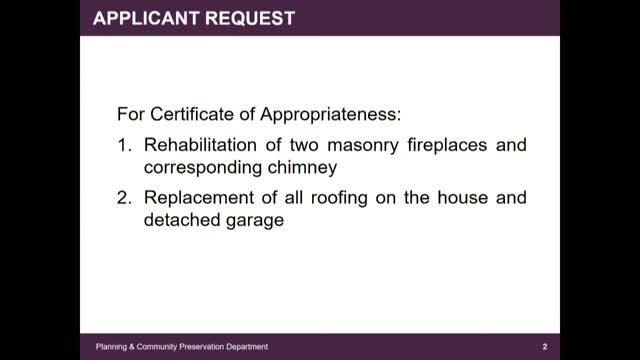Restoration project breathes new life into historic home
August 02, 2024 | Sierra Madre City, Los Angeles County, California

This article was created by AI summarizing key points discussed. AI makes mistakes, so for full details and context, please refer to the video of the full meeting. Please report any errors so we can fix them. Report an error »

In a recent government meeting, officials discussed a significant rehabilitation project for a historic property located on West Sir Madre Boulevard. The project involves the restoration of two masonry fireplaces and their corresponding chimney, as well as the complete replacement of the roofing for both the main house and a detached garage.
The property, situated within a Residential High Density Land Use Designation and the R313 zone, is earmarked for multi-family development, allowing for up to 13 dwelling units per acre. Spanning approximately half an acre, it is surrounded by multifamily developments dating back to the 1960s and 70s. The site gained national recognition following a feature in the March 1908 issue of Craftsman Magazine, authored by renowned furniture designer Gustav Stickley. The article highlighted architect Louis B. Easton’s work on the property, which was completed on a modest budget of $6,000 at the time—equivalent to about $200,000 today.
The property faced challenges following the Sierra Madre earthquake in 1991, which caused extensive damage, particularly to the chimney and fireplaces. Original materials were salvaged and stored, and the home was at risk of demolition until it was purchased by local preservationists, the Songsters, who meticulously restored the property. Their efforts included replanting the original landscape design and restoring the back patio.
The home was again featured in the 2011 issue of American Bungalow Magazine, which detailed the Songsters' restoration journey and the craftsmanship of Easton, despite his amateur status at the time of construction. The rehabilitation plan includes reconstructing the damaged chimney to a height of 22 feet and 3 inches, incorporating modern materials for durability and fire resistance.
The proposed roofing will utilize a composition shingle material, designed for fire resistance and available in various colors. This project not only aims to preserve the architectural integrity of the historic property but also to enhance its resilience against future seismic events.
The property, situated within a Residential High Density Land Use Designation and the R313 zone, is earmarked for multi-family development, allowing for up to 13 dwelling units per acre. Spanning approximately half an acre, it is surrounded by multifamily developments dating back to the 1960s and 70s. The site gained national recognition following a feature in the March 1908 issue of Craftsman Magazine, authored by renowned furniture designer Gustav Stickley. The article highlighted architect Louis B. Easton’s work on the property, which was completed on a modest budget of $6,000 at the time—equivalent to about $200,000 today.
The property faced challenges following the Sierra Madre earthquake in 1991, which caused extensive damage, particularly to the chimney and fireplaces. Original materials were salvaged and stored, and the home was at risk of demolition until it was purchased by local preservationists, the Songsters, who meticulously restored the property. Their efforts included replanting the original landscape design and restoring the back patio.
The home was again featured in the 2011 issue of American Bungalow Magazine, which detailed the Songsters' restoration journey and the craftsmanship of Easton, despite his amateur status at the time of construction. The rehabilitation plan includes reconstructing the damaged chimney to a height of 22 feet and 3 inches, incorporating modern materials for durability and fire resistance.
The proposed roofing will utilize a composition shingle material, designed for fire resistance and available in various colors. This project not only aims to preserve the architectural integrity of the historic property but also to enhance its resilience against future seismic events.
View full meeting
This article is based on a recent meeting—watch the full video and explore the complete transcript for deeper insights into the discussion.
View full meeting
